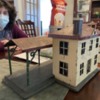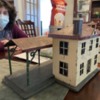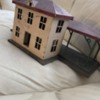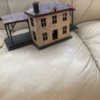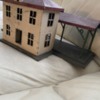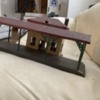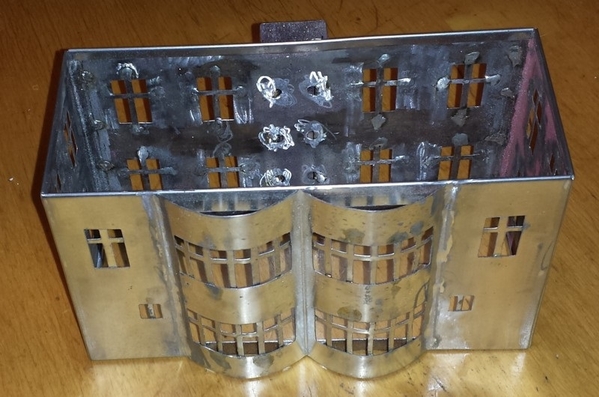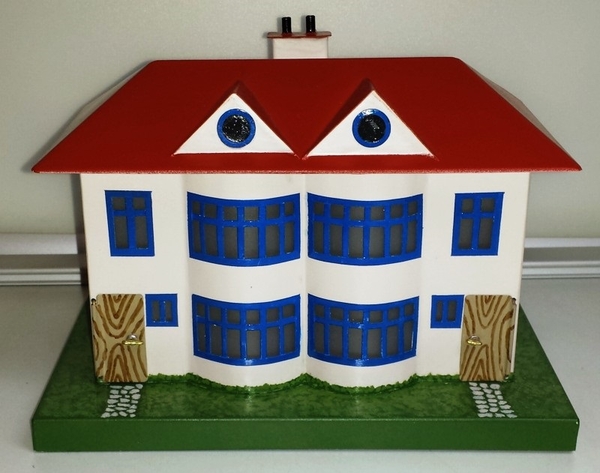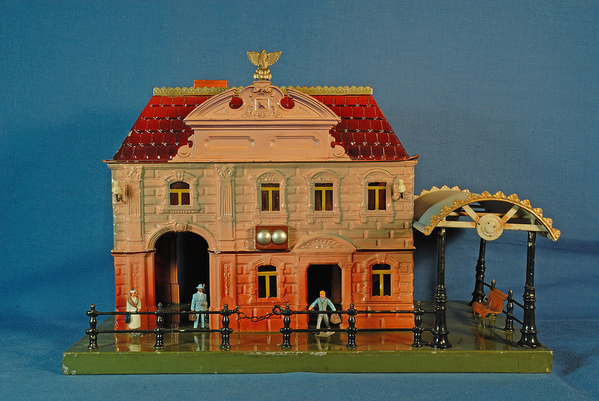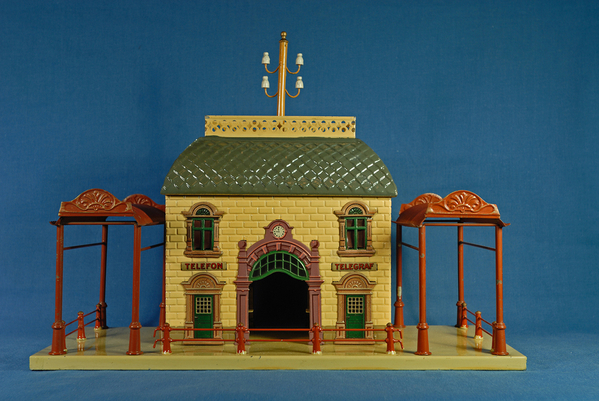Hi all can anyone help me identify who built this standard gauge station and when? thanks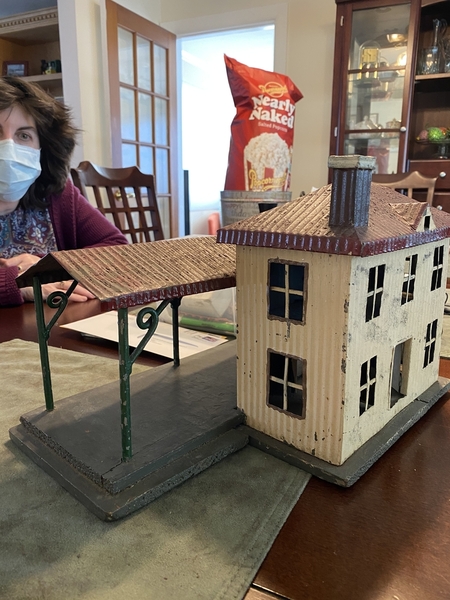

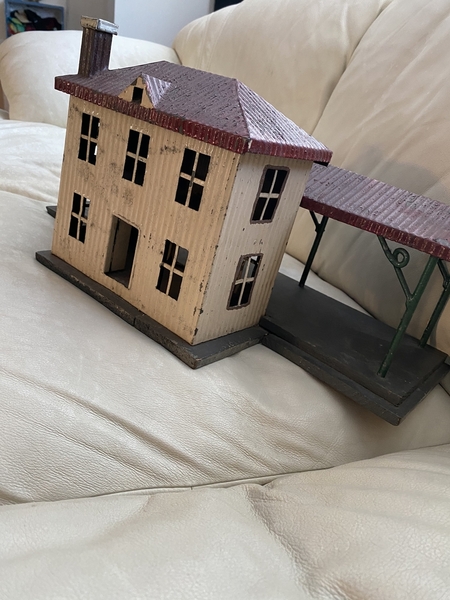

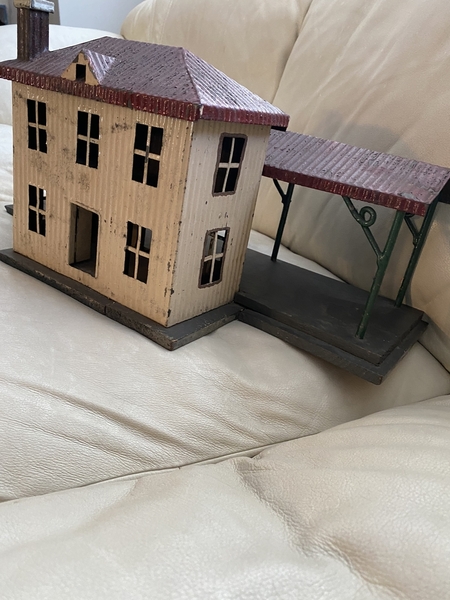
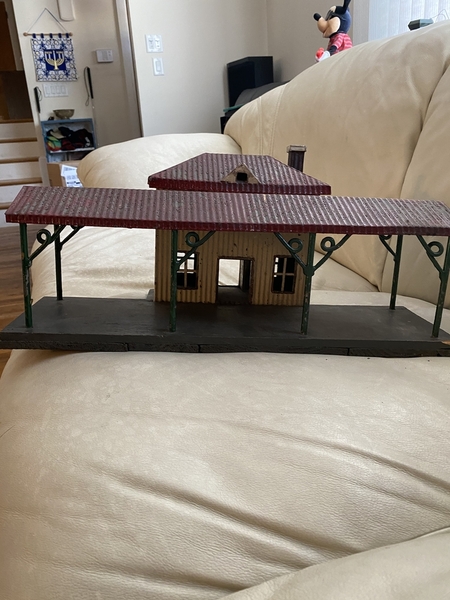
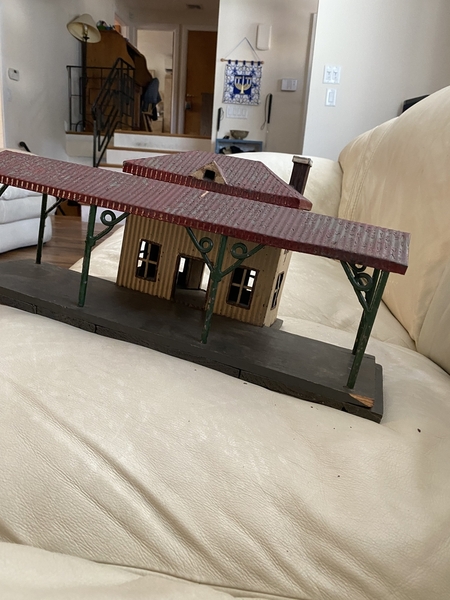
Replies sorted oldest to newest
P.s. It is about 15 inches wide and about 8 inches deep. The base is two pieces of wood and the rest of it is metal.
Suggest you ask the webmaster of binnsroad.co.uk. It might be an old European manufacturer.
I agree it does look european to me , roof texture wise anyway , but then I would question the wooden base , which is incongruous to my eyes ?
When in doubt call in the heavy hitters for all things continental ... @Arne @FRENCHTRAINS calling Arne and Frenchie .. cleanup in Aisle 3 ??? ![]()
I suspect that the station is homemade also, because of the somewhat simple design of the posts that hold up the platform roof. The Y supports look like they just have simple loops and appear to be soldered to the main post.
NWL
Hi guys, thank you everyone for the very informative opinions. As a home brew item how much time and work goes into something like this?
I am firmly in the camp it was not homemade. This is from a manufacturer. The station and platform roof fascia are bent from the roof stamping. Those were stamped from a pattern, not cut with tin sheers. It is put together too cleanly to be homemade back in the day. Schuco, or whatever the manufacturer Lionel imported from Germany in the 1900's. I'm sure the true origins will be discovered.
Chuck, thanks for the opposing position. I love a good mystery, but this one has me stumped. It all ads to its charm.
@Chuck Sartor posted:I am firmly in the camp it was not homemade. This is from a manufacturer. The station and platform roof fascia are bent from the roof stamping. Those were stamped from a pattern, not cut with tin sheers. It is put together too cleanly to be homemade back in the day. Schuco, or whatever the manufacturer Lionel imported from Germany in the 1900's. I'm sure the true origins will be discovered.
Given the limited nature and quality of the photos, I don't think that one can really say that it is put together too cleanly to be homemade. There were a lot of craftsmen back in the era who had access to many more tools than most of us have today. It certainly appears to be a good job, but it certainly could have been done by someone who worked with metals and had access to tooling.
One additional feature that leads me to believe it is a homemade item, is that the roof, chimney, and building sheet metal have the same corrugated pattern. This would lead me to believe that the individual who made this had limited access to sheet metal or limited funds to purchase such sheet metal.
Another very unusual feature of the building is that the chimney is attached to 2 different sections of the roof. This seems very unusual and I think is a further sign that this is homemade.
Further examination finds that the length of the roof edges on each end vary. I note that the edge of the roof on the end with the chimney is almost the same length as each of the sides, but the bend downward appears to occur at a higher point than the sides, and the edge of the roof on the end without the chimney is noticeably shorter than the sides on that end. This points to the fact that these pieces were not uniformly cut and stamped out by a press.
Further examination of the wooden base points to this being homemade. If you look closely at the photos (I saved them to my computer and then zoomed in on them), you will note that the wooden base is not made of 2 pieces, but rather there are 2 levels to the base, with the top level, which is made out of a single piece of wood, being solely related to the platform. However, the lower part of the base is made out of 4 different pieces of wood. There are 2 different pieces of wood under the building with a smaller piece on the side without the chimney (note the joint under the building, which can be seen under the platform in the corresponding place) and then separate pieces of wood that are only under the platform on each side of the building (again look for the joints).
If this was truly a mass produced item, there would simply be 1 or 2 pieces of wood, not 4 pieces comprising the lower level and then one piece on the top level tying them together and there certainly would not be 2 different pieces of wood under the building.
What I see is window cut outs are cleanly stamped out. How was this done home made? The green wire platform roof supports are heavy gauge wire, the circles are too perfect to be bent without machine help. The cream colored station paint was applied by a machine. If it was homemade, it would have been painted by hand. Also the patina and chips in the corners of station. I still say not homemade. Maybe Vollmer or Kibri. More picture would help. Underside of station and platform roof, inside the station building may provide more clues.
@Chuck Sartor posted:What I see is window cut outs are cleanly stamped out. How was this done home made? The green wire platform roof supports are heavy gauge wire, the circles are too perfect to be bent without machine help. The cream colored station paint was applied by a machine. If it was homemade, it would have been painted by hand. Also the patina and chips in the corners of station. I still say not homemade. Maybe Vollmer or Kibri. More picture would help. Underside of station and platform roof, inside the station building may provide more clues.
You seem to think that homemade implies using tin snips and no machine help. I am in no way implying this. I think whomever made this station had access to some sort of metal shop / machinery and was very skilled at metalworking.
I also don't think you can state from the pictures that the paint was applied by a machine. The paint looks very heavy/thick and the photos are not of sufficient detail to discern how the paint was applied.
As for patina, the paint is obviously original to the construction of the piece and/or is very old, so there is going to be patina, which really proves nothing about its manufacture.
You point toward Vollmer and Kibri as potential manufacturers, which seems odd, as these companies were not producing trains until the postwar era of the late 1940s or early 1950s, a time frame, which this station does not appear to have been made, as it is out of scale for that time frame and much too crudely constructed for models of that time.
Gents, overall it first appears to be home madebut the roof supports and windows strike me as machine shop ormass production. I agree that it ismostlikely pre-war. I don't have any usable eyeballs so I don't trust myself to take more pictures but I'll have a friend over this weekend who can maybe take some more. Sorry, all I have is the camera on my phone.
P.S. I have many other pre-war buildings from a variety of makers. One of the oddities of this building that the gauge of the roof and walls is much heavier metal than anything else I have xperiences. That may not be obvious in the photos. Could this have been a kit?
The eves on the platform roof and station look professional. My question is, does the station construction have all four walls soldered together, or just in one corner? Train accessories of that period were all assembled by hand at the factory. The cap on the chimney looks interesting. If it is home made, my hat is off.
@ChooChoo1972 posted:One of the oddities of this building that the gauge of the roof and walls is much heavier metal than anything else I have xperiences.
I think the use of heavier gauge steel of the roof and walls that the OP notes, further points to this being homemade by a skilled craftsman. The train companies of the prewar era tended to use lighter gauge metal, which was easier to work with and less expensive. A heavier gauge of steel would have been more costly (which would lower profit) and be more difficult to work with.
I think that looking at the construction (from the inside of the building) would provide more information. I did note that there appears to be a rivet or screw at the center of each end wall (between the upper and lower windows), which may be attached to some sort of bracket inside.
@Kent Locomotive Works posted:Sorta looks like a bing to me, possibly kitbashed back in the day?
Bing had better quality looking buildings than this. They were much more ornamental with fine details.
Even a kitbashed Bing would have more ornamentation than this station - here's two examples of Bing - the first from 1912 and the second from ca. 1928.
1912
1928
Based on my references the 1928 station was cataloged from 1912 to 1928 - in the earlier catalogs is was listed as #7063 and in the later catalogs as 10/618 - to the best of my knowledge what changed over time was the complexity of the paint scheme. The earlier stations had more gradations of colors applied to the exterior whereas the later versions were simplified.




